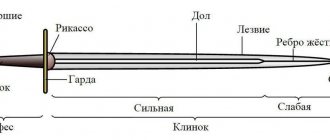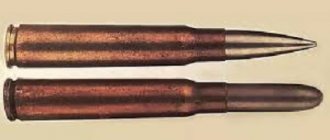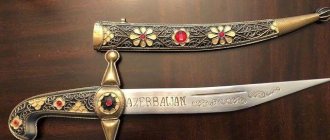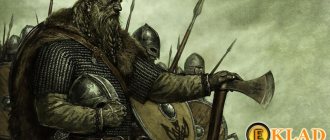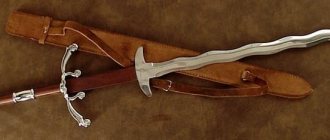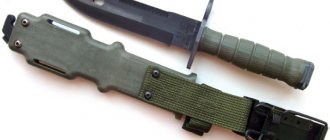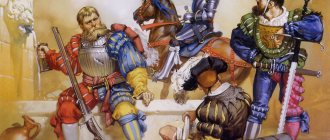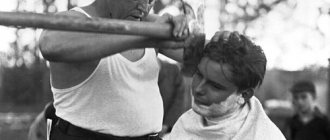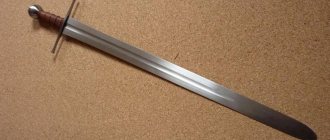Weapon Arsenal
By exploring this site you can familiarize yourself with the following main sections, which provide a detailed description of the corresponding European bladed weapons.
Carolingian type sword
The Carolingian type sword is a direct descendant of the spatha and the direct ancestor of the knight's sword. In fact, it should be called a "Viking Age sword", since these swords belong to a certain era, and they were carried by all the wars of the period 7th - 10th centuries, and not just the Vikings.
One-handed sword
The lion's share of all swords of the Middle Ages were one-handed swords. The tradition runs from the swords of the ancient Germans and Vikings through the knight's swords to the early forms of rapiers and broadswords.
Long sword
The late medieval longsword is an elegant weapon that led to the rise of medieval fencing.
Two-handed sword
The two-handed sword of the Renaissance is clearly different from the “bastard swords” of the Middle Ages. The difference lies not only in the details of the form, but primarily in length, weight and use in battle.
Rapier
The rapier is a type of one-handed sword, in fact, the original name is espadas roperas, translated from Spanish as a sword for clothes.
Sword
The word epee is a corruption of the Italian word spada in Russian, which translates as sword. In our case, by sword we mean a weapon, which in English literature is referred to as a small sword - a small sword.
Sword
Early forms of the broadsword appeared at the beginning of the 16th century, and were a type of one-handed sword equipped with a basket guard.
Saber
Sabers and curved swords were not widespread in medieval Europe. And only from the middle of the 15th century, when the influence of the Ottoman state increased in Eastern Europe, the saber began to confidently replace the sword in these regions.
How to finish off the poor knight? (Swords and daggers of the Middle Ages - part two)
5:1 “...And you, son of man, take yourself a sharp knife” (Book of Yezra)
No one wants to die in battle, either for a just cause or for a wrong one, and a person does this only out of necessity. For this reason, in the past, people hung themselves with all sorts of iron, which protected them from arrows, swords and spears, so that they could not be reached, but on top of everything else, all this knightly armor was also a kind of password that told everyone, who saw a man in such a robe: “I am an iron hen that lays golden eggs! Why kill me when you can take a ransom from me?!” And in fact, at first knights died more often in tournaments than in battles, because they felt like some kind of world order, and who in this case kills a “fellow in the craft”? That is why, for at least two whole centuries, such an important type of weapon as a dagger was simply not included in the arsenal of knightly weapons and, accordingly, was not depicted in miniatures in manuscripts. Moreover, turning to such a highly reliable source of information about the past as effigies, we ... will not see even a hint of a dagger on any of the early figures. All of them are depicted with swords. Some even have a pouch on their belt, others have visible clasps in the slots of the surcoat on the side or a quilted lining on the haunch robe, but what you won’t find on them is a dagger! That is, until a certain moment, the knight had with him only a sword, and, accordingly, a spear.
However, time passed, and the knights acquired, in addition to the sword, a dagger. And today our story will tell about the most famous types of these weapons, which served to... finish off one’s fellow craftsman, if the need arose.
Perhaps the earliest effigie with a dagger hanging from her belt is this one. And it belongs to the knight Gottfried von Cappenberg and dates back to 1250, in Kloster Cappenberg, in the state of North Westphalia, in Germany.
Taking a closer look, it is not difficult to notice that on his belt hangs a ballok (or bollok), which was also colloquially called a “kidney dagger” (due to the manner of wearing it in some European countries), and, in purely masculine terms, a “dagger with eggs” "- due to its resemblance to the male reproductive organ (bollocks - testicles or testicles in English).
Bullock 1450 – 1499 Royal Arsenal, Leeds. As you can see, the blade of this dagger is almost a tetrahedral awl. It is impossible for them to cut sausage, but a blow to the chain mail will definitely tear it! Length 360 mm, blade length: 240 mm Weight: 190 g. Scottish ballock from the early 17th century. Length: 455 mm. Blade length: 342 mm. Weight: 310 g (Metropolitan Museum, New York)
A dagger of this type also had a characteristic handle that widened towards the end and a durable double-edged blade. It very quickly gained popularity among the knights of Northern Europe, as well as in England and Flanders, but did not last long in the arms market of the nobility, as more advanced examples of daggers for the “final blow” appeared on it.
Effigy of the knight William de Gorges, d. 1346 Buried at Tamerton Foliot. The knight is wearing typical weapons of the transition period from chain mail to plate armor. From under the fabric jupon, the jagged hem of the chain mail is visible, the legs are covered with armor, with characteristic “shell” wings. The knight's belt, richly decorated, lies horizontally on the hips, and on it, as can be very clearly seen, in addition to the sword, a ballok is strengthened on the left side.
A perfectly preserved (and, of course, carefully restored) effigy of Pieter de Grandissant, d. 1358, from Hereford Cathedral, shows us an original example of a “genital dagger”, which is a kind of hybrid between a typical ballock (characteristic convexities on the handle of the blade) and a baselard dagger - a characteristic pommel of the handle in the shape of the letter “T”. The blade has a rhombic shape and tapers evenly towards the tip.
But the bullet did not disappear at all, but became a reliable weapon of self-defense for merchants and all other representatives of the medieval middle class: it was convenient for them to defend themselves against robbers, but they did not have to face those who wore “white armor.” There were ballocks that were very crudely made, perhaps forged at the village forge. In cases where the ballok blade was triangular with a blade, it could have an unsharpened part (ricasso) near the handle. At the end of the 15th century, the sheath of the ballocks received a “pocket” for an awl or a small knife for household needs, everything is exactly the same as that of the medieval Japanese with their tanto and wakizashi daggers. Moreover, they were usually made of leather, wood, and even silver. It was only by the 16th century that the ballock was finally supplanted by rondel-type daggers, but in England it turned into the national Scottish “dirk”.
Modern Scottish dirk.
As for the “baselard” dagger, it comes from the name of the Swiss city of Basel, that is, it can be translated as “Basel”, “dagger from Basel”. Its main feature was the handle in the shape of the Latin letter “H” with an elongated crossbar. Such a hilt provided strong support for the hand, so it was quite difficult for such a dagger to slip out of it, especially if its hilt was made according to the hand of its owner. Moreover, by sticking it, so to speak, “into the object of influence” and pressing from above on the upper crossbar “T” of its handle, it was possible to develop a very large force and thus cut through chain mail, or even pierce plate armor.
The effigy of the Italian knight Gerarduccio de Gherardini from Tuscany, who died in 1331 and was buried in the Church of St. Apolliano Barberino d'Elsa. His baselard looks more like a sword than a dagger!
Effigy Olbrecht von Hohenlohe, d. 1338 St. Joseph's Cathedral in Schontal.
The heyday of the baselard came in the 14th-15th centuries, when the knights of Italy and Germany, for whom it could reach a length of 90 cm, and the Swiss landsknechts were especially fond of it.
Baselard 1300 – 1399 Royal Arsenal, Leeds.
And again, very soon the baselard became a popular weapon among merchants, urban artisans and... wealthy peasants who also wanted to go armed. Interestingly, in the 15th century, daggers of this type began to be called “Swiss daggers” or “Holbein daggers” (named after the famous medieval artist). The last known mention of the word "baselard" is found in an inventory of weapons made in 1602 in Scotland. The gunsmiths of the Third Reich also copied their shape in their award daggers.
Rondel 1400 – 1430 Royal Arsenal, Leeds. Both guards are made of metal discs. Length: 335 mm, blade length: 226 mm, weight: 0.2268 g.
Rondelle with prefabricated disks made of wood and metal 1400 - 1499. Royal Arsenal, Leeds. Length: 350 mm, blade length: 212 mm, weight: 230 g.
Rondel handle 1400 – 1499. close-up.
However, the most popular dagger of the Middle Ages became the rondel - a highly functional weapon of chivalric times. This dagger appeared at the turn of the 13th-14th centuries, when there was an active struggle for power in Europe. The main distinctive feature of this dagger is its characteristic round guard and the same pommel at the hilt - hence, in fact, the name of this dagger, since rond in French and round in English means “circle”. Even with the most powerful blows of this dagger against the metal of the armor, the disc guard did not allow the hand to slip onto the blade, and when removing it from the wound, it did not allow it to slide off the handle!
Do not be surprised! This is not a woman, but the effigy of the knight Johann Kammerer, who died in 1415. Oppenheim, St. Church. Katerina. On the belt is a rondel in a richly decorated sheath.
Today it is difficult and even impossible to say where exactly it appeared for the first time. However, it was loved in England, Germany, and France, and was also used in Scandinavia and Hungary. The rondel blade was usually flat, needle-shaped, with a handle made of wood, bone or horn. But at the same time as their military purpose, rondels were a fashionable status weapon for self-defense, which all more or less wealthy people sought to acquire at that time. Daggers with a short blade were usually worn by women.
Another rondel on the belt of the effigy of Archbishop von Trier, d. 1340 Mainz, Landmuseum.
Quillon effigy of John de Lyons, d. 1350 Warkworth. Quilon (from the French word quillon - crossbar, crosspiece) is originally a knight's dagger, which was a smaller copy of a knight's sword. This dagger got its name because of the cross-shaped arches of the guard.
The early quilons (XIII century) most closely resembled a shortened sword, just of a reduced size. Quilon was used until the 18th century. The cross section of the blade is diamond-shaped. The handle, usually cylindrical, could have a pommel of a variety of styles.
Brass – chased metal tombstone of John Gray, d. 1392 Chinnor.
The “eared dagger” with characteristic “ears” was popular in the 14th-16th centuries. It was named so because of the two discs that looked like ears, which were attached to the head of the handle. It was also called the “Burgundian Dagger” and the “Levantine Daga”, according to the places of distribution. Length 193 mm, length 317 mm.
Italian effigies from the book by D. Nicolle “Nicolle D. Arms and Armor of the Crusading Era 1050-1350: Western Europe and the Crusader States” (Greenhill Books, 1999). The side effigies have baslards characteristic of Italians hanging on their belts, but the middle one has an original eared dagger with two pairs of “ears”. Rice. A. Shepsa.
At first, for some reason, both disks were located almost along the handle, but then they began to be moved more and more apart. The discs were decorated and covered with plates of bone and metal. This dagger had no guard. To give them a strong piercing blow, you had to rest your thumb on the V-shaped fork between the “ears” of the pommel. The blade had a double-sided sharpening, but one blade was slightly shorter than the other. The scabbard was wooden, covered with leather. It is believed that these weapons served more for decoration than they were actually used. On the other hand, it is known that this dagger was the favorite weapon of Italian assassins.
Sword manufacturers
One of the reasons that prompted me to create this site was that the master gunsmiths involved in the production of swords and other bladed weapons in Russia and neighboring countries were too far from each other. My goal was to collect many of them on one site. Firstly, so that users interested in bladed weapons can find a suitable master and get acquainted with his work, secondly, they can look at the weapon and its parameters in order to order something similar from a suitable master, and so that gunsmiths can see each other’s work, expand range of your works and improve your skills.
Manufacturers of bladed weapons
In this section you can get acquainted with well-known and not so well-known manufacturers of bladed weapons, see their works, find out prices and contact information.
Features of weapon production in the Middle Ages
Unique medieval weapons
Mastering new metal processing technologies, gunsmiths introduced innovations in the production of weapons. Often gunsmiths worked on individual orders. This explains the wide variety of melee bladed weapons, their properties and appearance. The transition to conveyor production became possible with the development of manufacturing enterprises. Less and less attention was paid to the appearance of the weapon; the main goal was to achieve effective combat qualities. Large organizations still failed to completely displace individual workshops for the production of edged weapons. There have always been workshops for the production of unique types of weapons for defense or offensive. A specific craftsman could be identified by a typical mark or marking. Regardless of appearance, weapons of the same type performed the same functions.
Fencing
The section provides an overview of the development of the art of fencing from the 14th to the 18th centuries. The section presents clubs involved in the development of historical fencing in Russia.
History of fencing
If you are interested in a complete overview of the development of fencing art in Europe, then I advise you to immediately read Egerton Castle’s book “Schools and Masters of Fencing.” In this book you will find not only interesting facts from the history of fencing, but also a thorough analysis of the main fencing treatises of famous masters of the 16th - 18th centuries.
History of the first use of gunpowder
Greek fire
It is difficult to determine when fireworks and rockets began to be made from saltpeter. However, the fact that the Chinese invented guns is undeniable. Chinese chronicles from the 7th century describe the process of throwing shells from cannons using an explosive mixture. At the same time, they learned to “grow” saltpeter. For its formation, special pits with manure were created. When the method of obtaining saltpeter spread, its use for military operations became more common. After rockets and flamethrowers, firearms were invented.
The Arabs used gunpowder in the 11th century. Europeans acquired information about the properties of saltpeter at the beginning of the 13th century, after the conquest of Constantinople by the Crusaders. European scientists studied the method of creating "sea fire", and by the mid-13th century there were descriptions of exploding gunpowder.
According to the standard, gunpowder consisted of 60% saltpeter, 20% sulfur and charcoal. The first component is the main one, and sulfur was not used in all formulations. It was needed to ignite the substance from a spark. If other methods of ignition were used, it was not required.
Charcoal is also not the most important component. It was often replaced with cotton wool, dried sawdust, cornflower flowers or brown coal. This only changed the color of the composition and its name - this is how white, brown, blue and black powder were distinguished.
Combat grip or “catcher of men”
One of the few medieval weapons whose purpose was not murder. The "catcher of men" was designed to grab and throw riders from their horses. It was a kind of grip with internal spikes. It was assumed that the warriors of that time were in armor and these spikes did not injure them, but only held them back. With the help of this weapon, knights were captured and later demanded a ransom.
4
Hand grip
Soldier with handbrake
In the middle of the 12th century, the Chinese used the hand crank, the first hand-held firearm. At the same time, the Moors used a similar device. In China it was called pao, among the Moors it was called modfa and carab. The currently known name “carbine” comes from the name “karab”.
At the beginning of the 14th century, similar tools began to appear among Europeans. There were many varieties: hand bombard, petrinal, culverina, hand cannon, sklopetta and handcanon.
The handle weighed 4-8 kg. It was a smaller version of a cannon. To make it, a hole was drilled in a piece of copper or bronze. The barrel was 25-50 cm long, with a caliber of more than 30 mm. Round lead bullets were used as a projectile. However, until the 15th century, cloth-wrapped stones were more commonly used, as lead was rarely found.
A pertinal is a gun that uses stone bullets. It was called so from the word “petros” - stone. It was most often used in Italy. The weapon was mounted on a wooden rod, the end of which was held with the inner part of the shoulder bend. In addition, the weapon was held with one hand. The second – the charge was ignited. For ignition, a wooden stick soaked in saltpeter was used. Sparks from the stick fell inside the barrel and ignited the gunpowder. This was the most primitive type of castle among its varieties.
Kulevrina looked like a classic firearm. From her came muskets and arquebuses. In addition to hand culverins, there were also huge tools with this name. The type of lock on the culverin was wick.
Sklopetta also had another name - hand mortar. This is a device similar to modern grenade launchers. The trunk length is 10-30 cm. The trunk was short and wide. This weapon is equipped with a matchlock, common for that time.
The first firearms did not shoot accurately and only at close range, so they could only shoot at close range. The distance to the target should not exceed 15 meters. However, from this distance the armor was easily penetrated. Without armor, especially since the invention caused great damage to enemies.
The time after which the “fire tube” would fire was completely unpredictable. This feature and the bulkiness of the gun made it difficult to aim. The huge recoil when firing did not contribute to accuracy.
Hand grip
However, accuracy was not the initial concern at that time. Smoke, noise, and explosion frightened horses and enemies, which gave a great advantage in battle. Sometimes firearms were deliberately fired empty, so that the even formation of the enemy soldier would become confused and lose combat effectiveness.
Although the horse, accustomed to fighting, was not afraid of fire, firearms were a new threat for it. Out of fright, she often threw off the rider. Later, when gunpowder ceased to be expensive and rare, horses were able to be taught not to be afraid of the effects accompanying a shot, but this took a lot of time.
People who were not accustomed to the peculiarities of firearms were also afraid of the smell of sulfur and noise. Peoples who did not use hand grips had many superstitions associated with them. Superstitious soldiers associated brimstone, fire and clouds of smoke with demons and hell. Until the 17th century, these weapons frightened many.
Weapons of knights and the “star” of tournaments
From the very beginning, the battle ax was part of the mandatory program of the knightly tournament. And everyone was aware of its danger, including the knights themselves. Thus, the French king Francis I refused to fight with his English colleague Henry VIII on pollex due to the fact that “there are no mittens that can sufficiently protect the hand.” And these are the words of the almighty king!
However, not everyone paid attention to such a trifle as injuries. A great fan of crossing battle axes was the French knight Jacques de Lalen, who lived in the mid-15th century. Here is a chronicle of just a few of his fights.
1445, Antwerp, battle with the Italian knight Jean de Boniface. By the time it came to the pollaxes, the fighters managed to break six spears and continued the battle. When the turn of the pollaxes finally came, Jacques dealt de Boniface such a blow that he almost twisted him!
1447, Castilla, battle against Diego de Guzman. When Jacques and Diego fought on the pollex, their blows were so violent that sparks flew from the armor.
1447, Flanders, battle with the English squire Thomas Kew. During the battle, Thomas hit Jacques de Lalaine in the hand with the spike of his pollex. The point penetrated under the glove and passed through, “cutting nerves and veins, since the spike of the Englishman’s ax was surprisingly large and sharp.” Seeing that things were going badly, Jacques threw away his pollax and threw Thomas Q to the ground, thus winning the fight. Fortunately for the winner, the wound he received did not cripple him.
Arquebus
Arquebus
The first home-made weapon did not compete too much with bows and crossbows. However, thanks to the development and invention of new types of firearms, by 1530 their use became more effective. They started making the ignition hole on the side. Next to it was a shelf for ignition powder. Unlike previous varieties of culverin, this gunpowder flared up quickly. It instantly ignited inside the barrel. Thanks to these innovations, the gun began to shoot quickly and was easier to aim. The percentage of misfires has decreased significantly. The main innovation was the mechanization of the process of lowering the wick, with the help of which the gunpowder was ignited.
In the second half of the 15th century, this gun received a lock and a butt - details previously characteristic only of crossbows.
The metal also became better. Technologies for its processing improved, tools were made from the purest and softest iron. Previously, the pipe could burst when fired. After these changes, such failures occurred less frequently. Drilling methods also improved and gun barrels began to be made longer and lighter.
The appearance of the arquebus is the result of all these improvements. Its caliber is 13-18 mm, weight - 3-4 kg, barrel length - 50-70 cm. A medium-sized arquebus fired bullets weighing 20 grams with an initial speed of 300 meters per second. Compared to previous types of weapons, the external damage caused did not look colossal. The bullet could not shoot off part of the enemy's body. However, even a small bullet hole was fatal. This gun could penetrate armor from 30 meters.
However, the shooting accuracy was still low. It was possible to successfully shoot at a soldier from 20-25 meters, but from 120 meters there was no chance of hitting even the combat formation. The development of guns slowed down until the middle of the 19th century. Only the castle was improved. In modern times, guns effectively shoot no further than 50 meters. Their advantage is not accuracy, but the power of the shot.
Charging the arquebus was difficult. The smoldering cord for igniting the charges was disconnected from the weapon and hidden in a special metal case. To prevent it from going out, there were slots in the container for air. The required amount of gunpowder was poured from the cartridge case into the barrel. Then, using a special rod - a ramrod, the gunpowder moved along the barrel to the treasury. A felt plug was inserted behind the explosive mixture to prevent the mixture from spilling out of the barrel, then a bullet and another plug. At the end, a little more gunpowder was added to the shelf. The shelf lid was closed, and the wick was attached back. An experienced warrior could do all these actions in 2 minutes.
The popularity of arquebuses in the second half of the 15th century is surprising. It began to be used much more often than bows and crossbows, despite the poor quality of the weapon. In traditional competitions, guns performed worse than crossbows. The ability to penetrate targets was the same for the bullet and the bolt. However, the crossbow did not have to be loaded as long, and it could fire 4-8 times more often. In addition, it was possible to hit the target from 150 meters.
In fact, the conditions of the tournament were very different from the conditions of the war. The positive qualities of the crossbow were sharply devalued in real conditions. During the competition, the target does not move and the distance to it is precisely calculated. In battle, a shot from a crossbow could be hindered by the wind, the movements of enemies and the inconsistent distance between them.
The obvious advantage of bullets was that they did not slip off armor, but penetrated it. They can also penetrate the shield. It was impossible to evade them. The rate of fire of the crossbow also made no sense - the enemies on horseback moved so quickly that it was impossible to fire more than once with either a crossbow or a firearm.
A significant drawback of these guns was their cost. It was precisely because of the price of these weapons that the Cossacks used self-propelled guns and bows until the middle of the 17th century.
Pollex time.
It appeared on the battlefields in the 14th century and instantly gained wild popularity. It is called pollex. This is a battle ax on a long shaft, equipped with a war hammer and a faceted pike. In addition, on the reverse side the shaft was sometimes equipped with a spike, and - often, but not always - with special discs that covered the hands, rondels.
Askhat Khairov, “Wolves of Romagna” club (Tolyatti). Photo by Sergei Toropov
The Pollex is a purely infantry weapon. Judging by illustrations in ancient manuscripts, it could exceed the height of its owner.
In the first part, I said that battle axes did not have shafts bound with iron. However, the pollex is not exactly an axe, but rather a combination weapon. And so it, or rather its shaft, was often reinforced with longitudinal metal strips - so as not to be cut. This can also be found in the arsenal collection of the Austrian city of Graz - read and watch a photo tour of its halls here.
In the 16th century, pollaxes would fall out of use following plate armor. However, the idea of a reinforced shaft will be continued in tubular steel handles for axes and maces.
But that will all happen later. And in the 14th century, the most effective weapon of knights was the pollex, which easily killed even an enemy clad in armor.
The weapon turned out to be so dangerous that even in the 21st century its blunted model is prohibited for use at many historical festivals in Russia. The surviving textbooks perfectly show the troubles that this weapon could cause.
The technique of working with a pollex, reconstructed on the basis of these textbooks, can be seen in the video.
The pollex models used by fighters are not based on an axe, but on a war hammer. I will talk about this variety in the article “War Hammer”, which has not yet been written))). However, the video is quite revealing, and, which is very rare, of good quality.
Russian alternative to the musket
Pishchal
In Spain they used a musket, while Russian soldiers had a arquebus. In the 15th century, Rus' lagged behind in technical progress, and therefore the weapons were worse. It was not possible to produce high-quality iron and had to import it from Germany. The arquebus weighed the same as the musket, but the barrel was much shorter and the power was several times less.
Although it seems that these shortcomings were global, their importance is not high. Horses in Rus' were smaller than European ones, and therefore cavalry caused less damage. The arque's accuracy was good - it was possible to hit the target from 50 meters.
There were also lighter squeaks. They were called "curtain" because they could be worn on the back, attached with a belt. They were used by Cossacks on horseback. The parameters of this type of weapon were similar to an arquebus.
How did the cartridge appear?
There have been many attempts to improve the effectiveness of weapons. The invention of the automatic lock made pistols one-handed. There was no longer any need to waste time lighting the gunpowder; all that was needed was to pull the trigger.
There were also many attempts to reduce the loading speed. In the process of such experiments, the cartridge was invented. If previously you had to put bullets and gunpowder separately into the barrel, fix it all with special plugs and add gunpowder again, then the cartridge greatly simplified this task. It immediately included a bullet and gunpowder. Thanks to this invention, it was enough to put a cartridge and the required amount of gunpowder into the barrel. After which the device could be used. And in combination with the automatic lock, loading was simplified to the placement of cartridges.
Tests
The Birmingham Testing House represents another important stage in the manufacture of firearms - barrel testing. A much more powerful charge than what it was designed for is placed in the barrel and a shot is fired. If any signs of weakness are detected, such as swelling or cracking, the trunk is discarded. If the barrel has passed the test, it receives an official stamp indicating good quality. The Birmingham Inspection Chamber was founded by a decision of the English Parliament in 1813, since it was legally prohibited to trade in weapons that did not have the appropriate mark.
Weapons production flourished with the advent of the Industrial Revolution, influencing, in turn, the development of industry. The growth of cities and the migration of people in search of work from agricultural areas to the large industrial centers of England provided fertile ground for the flourishing of arms markets.
The influence of firearms on history
Firearms of the Middle Ages
Firearms have greatly changed the specifics of military operations. Before his advent, warriors used the physical strength of their own muscles to strike.
Explosive mixtures are progress in the development of military art and science. With the advent of such weapons, battle tactics began to change. Armor became increasingly irrelevant; to protect against bullets, fortifications were created and trenches were dug. Battles began to take place over long distances. In modern times, weapons continue to be improved, but in general these features have been preserved.
Quicklime
Like calcium oxide, quicklime is made by burning limestone in a kiln. Lime was ground into powder and used effectively in battles, especially naval battles. Most-beauty.ru found a good description of its use from the 13th century Roman writer Giles: “They made a large number of pots filled with quicklime, which were dropped from a height onto enemy ships. When hit hard, they break, forming a cloud of powder around them. The powder gets into the enemy's eyes and causes severe irritation. Almost blind, they cannot see or defend themselves properly.”
3
